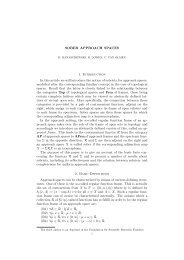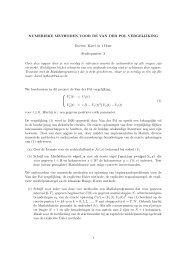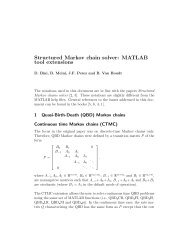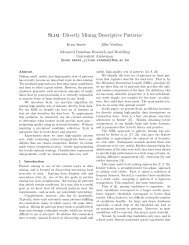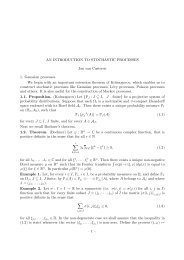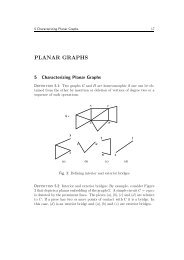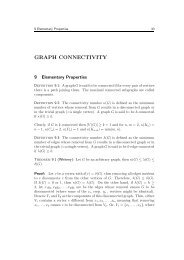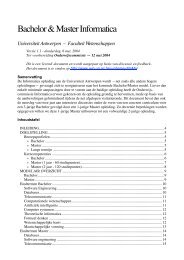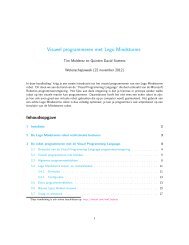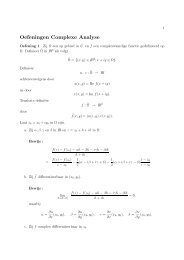Practical Rational Interpolation of Exact and Inexact Data Theory ...
Practical Rational Interpolation of Exact and Inexact Data Theory ...
Practical Rational Interpolation of Exact and Inexact Data Theory ...
You also want an ePaper? Increase the reach of your titles
YUMPU automatically turns print PDFs into web optimized ePapers that Google loves.
36 3. Interpolating continued fractions<br />
3.2 Werner’s algorithm<br />
Werner [Wer79] suggests a recursive method, based on successive continued<br />
fraction reductions <strong>and</strong> reordering <strong>of</strong> the data, such that the intermediate<br />
computations always remain bounded <strong>and</strong> such that insolubility <strong>of</strong> the problem<br />
can be detected. For the description <strong>of</strong> the algorithm it is assumed that<br />
1. ℓ ≥ m. If ℓ ≤ m, then we may swap the roles <strong>of</strong> ℓ <strong>and</strong> m <strong>and</strong> consider<br />
rm,ℓ(x) which interpolates 1/f(xi), xi ∈ Xn.<br />
2. f(xi) = 0, ∞ for xi ∈ Xn. We come back to the case f(xi) = 0, ∞ in<br />
Section 3.5.<br />
The algorithm recursively constructs a continued fraction representation <strong>of</strong><br />
a rational function R0(x)<br />
R0(x) = b0(x) + a0(x)<br />
b1(x)<br />
a1(x)<br />
+<br />
b2(x) + ... + an ′ −1(x)<br />
bn ′(x)<br />
, n ′ ≤ n (3.6)<br />
by applying continued fraction reductions <strong>of</strong> the form<br />
Rj(x) = bj(x) + aj(x)<br />
Rj+1(x)<br />
j = 0... ,n ′ − 1,<br />
where the polynomials aj(x) <strong>and</strong> bj(x) are determined by the interpolation<br />
conditions. Algorithm 3.2.1 clarifies the roles <strong>of</strong> bj(x) <strong>and</strong> aj(x).<br />
The algorithm has two different stopping criteria: in step 3a when all<br />
interpolation data have been processed, or in step 3(b)i in which case there<br />
are unattainable points. The second stopping criterion is motivated by the<br />
following Proposition.<br />
Proposition 3.2.1 (Werner [Wer79]). Let b(x) be the polynomial <strong>of</strong> degree<br />
∂b ≤ γ = ℓ − m that interpolates x0,...,xγ. If there exists an integer<br />
k ≥ ℓ + 1 such that<br />
b(xi) = 0 for i = γ + 1,... ,k − 1<br />
b(xi) = 0 for i = k,... ,ℓ + m,<br />
then the polynomials p ∗ (x) <strong>and</strong> q ∗ (x) given by<br />
q ∗ (x) =<br />
(x − xk)... (x − xℓ+m) if k − 1 < ℓ + m<br />
1 if k − 1 = ℓ + m<br />
p ∗ (x) = q ∗ (x) · b(x)<br />
solve the linearized rational interpolation problem (1.2).<br />
We remark that if the algorithm starts with f(xi) = 0, ∞, then by<br />
construction <strong>and</strong> (3.7), also Rj(xi) = 0, ∞ for xi ∈ Sj.



